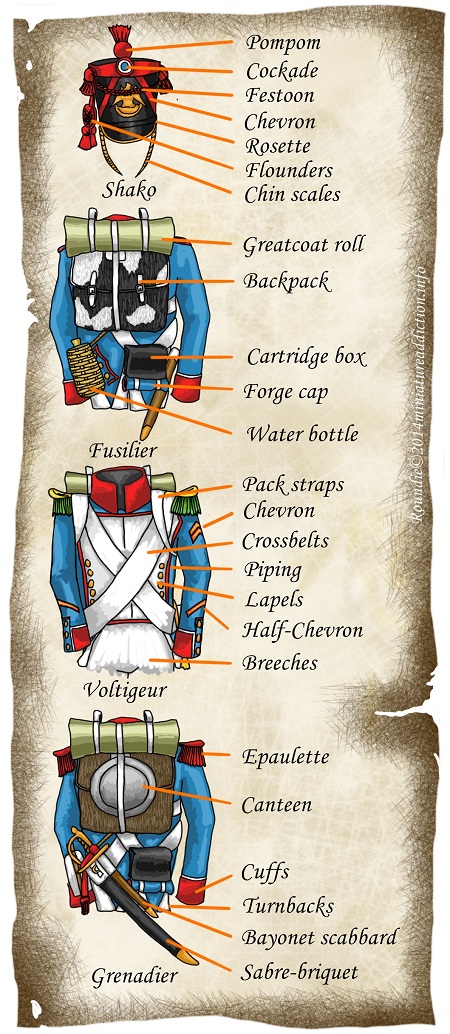It was not until I read chapter 22 (Dressed to Kill) of John R. Elting’s book Swords Around A Throne that I realized how non-uniform the French army’s uniform really was during the Napoleonic period. Coupled with the fact that when reading uniform guides that talk about changes to items I had never heard of made painting my first armies a bit of a hit and miss affair. To this end I have drawn up this little info sheet for anyone who is new to the Hobby or the French army of this period. I hope it is of some help to someone.

Pompom-Or Pompon, variations included padded cloth discs with a white centre bearing the battalions number.
Shako-For normal wear other than parade and battle, shakos were usually covered by waterproof coiffes, some models of which had neck flaps.
Festoons– Festoons and Flounders had been abolished by 1815.
Greatcoat–Capotes/redingotes Supposedly beige, but colours varied wildy. The redingotes was usually cut closer to the body (especially the hips) than the capotes. A more elegant item of dress it was usually reserved for officers.
Backpack– The French knapsack was made from cowhide, with the hair on the outside. Containing all the soldiers personal items it was usually worn into battle.
Cartridge box-Or Cartouche box held 35 pre-made cartridges, stowed ball end up in separate compartments. A clearing kit, spare flints and a piece of greasy cloth was stored in an outside pocket on the underside of the flap.
Forge cap– The Pokalem was introduced in 1812 and replaced the bonnet de police. A pie-shaped blue cap with a folding neck-flap the Pokalem could be fastened under the chin. It bore the regimental number or élite company badge on the front and was piped red.
Water Bottle-These were not issued to French soldiers who instead had to improvise their own. Carrying anything from gourds to wicker covered glass bottles.
Pack Straps–BuffletérieWere made from buffalo,bull or ox hide and were kept white with pipe clay.
(Upper) Chevrons– Length of service was shown by chervons d’anciennete. Worn pointing up on the upper left arm usually of red cloth with gold or silver braid for sergeants. one for ten years service, two for fifteen and three for more than twenty years.
Crossbelts-Centre companies had a single white strap the Banderole (or Porte-giberne) which supported both the cartridge box and bayonet. Elite companies had a second strap the Baudrier which held both the bayonet and sabre-briquet.
(Lower) Half-Chevron–Galons du grade were worn on both forearms just above the cuf. A corporal had two (usually aurore). Corporal-fourier had the same plus a narrow gold braid half-chavron on his upper left arm. Sergeants had one gold braid on the forearm (backed by a cloth strip of contrasting colour) and sergeant-majors had two.